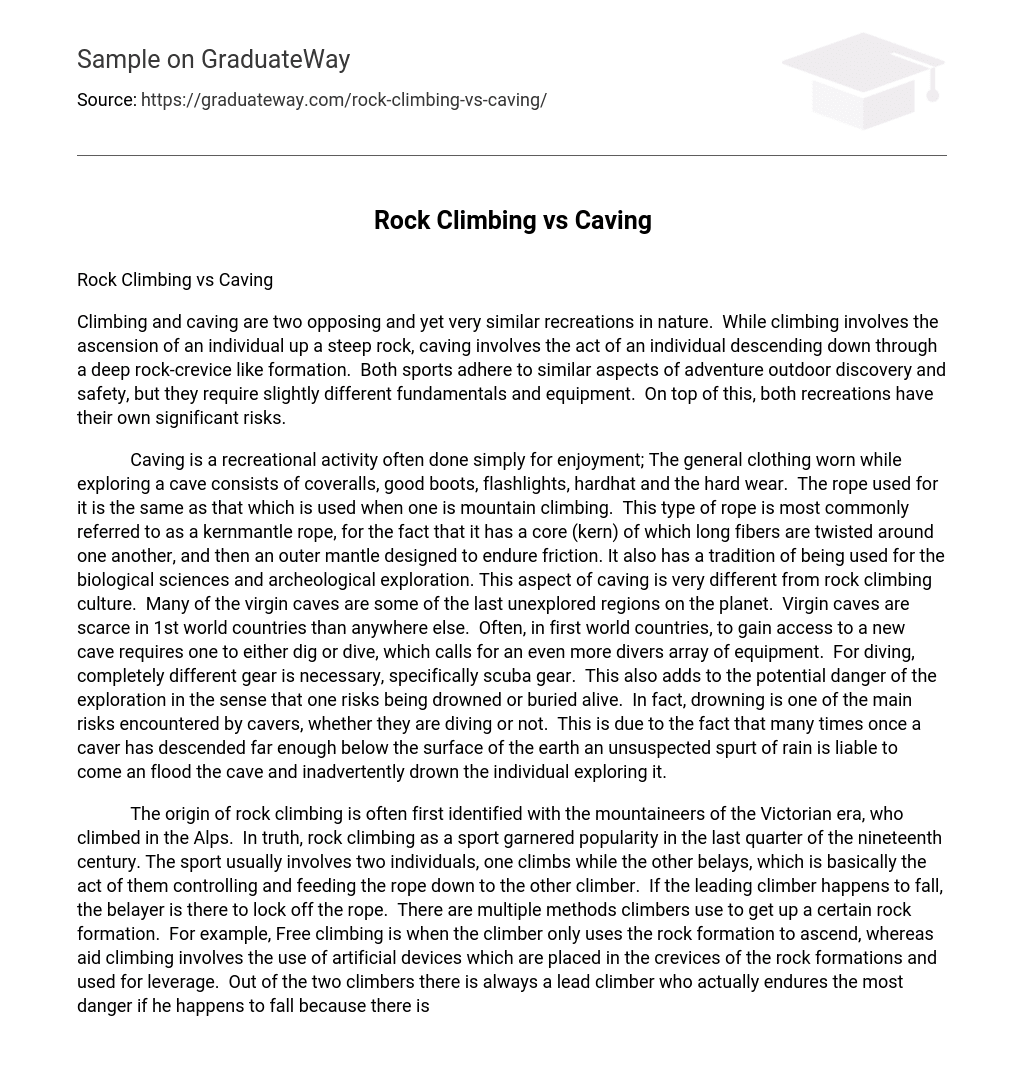Climbing and caving are two opposing and yet very similar recreations in nature. While climbing involves the ascension of an individual up a steep rock, caving involves the act of an individual descending down through a deep rock-crevice like formation. Both sports adhere to similar aspects of adventure outdoor discovery and safety, but they require slightly different fundamentals and equipment. On top of this, both recreations have their own significant risks.
Caving is a recreational activity often done simply for enjoyment; The general clothing worn while exploring a cave consists of coveralls, good boots, flashlights, hardhat and the hard wear. The rope used for it is the same as that which is used when one is mountain climbing. This type of rope is most commonly referred to as a kernmantle rope, for the fact that it has a core (kern) of which long fibers are twisted around one another, and then an outer mantle designed to endure friction. It also has a tradition of being used for the biological sciences and archeological exploration. This aspect of caving is very different from rock climbing culture.
Many of the virgin caves are some of the last unexplored regions on the planet. Virgin caves are scarce in 1st world countries than anywhere else. Often, in first world countries, to gain access to a new cave requires one to either dig or dive, which calls for an even more divers array of equipment. For diving, completely different gear is necessary, specifically scuba gear. This also adds to the potential danger of the exploration in the sense that one risks being drowned or buried alive.
In fact, drowning is one of the main risks encountered by cavers, whether they are diving or not. This is due to the fact that many times once a caver has descended far enough below the surface of the earth an unsuspected spurt of rain is liable to come an flood the cave and inadvertently drown the individual exploring it.
The origin of rock climbing is often first identified with the mountaineers of the Victorian era, who climbed in the Alps. In truth, rock climbing as a sport garnered popularity in the last quarter of the nineteenth century. The sport usually involves two individuals, one climbs while the other belays, which is basically the act of them controlling and feeding the rope down to the other climber. If the leading climber happens to fall, the belayer is there to lock off the rope.
There are multiple methods climbers use to get up a certain rock formation. For example, Free climbing is when the climber only uses the rock formation to ascend, whereas aid climbing involves the use of artificial devices which are placed in the crevices of the rock formations and used for leverage.
Out of the two climbers there is always a lead climber who actually endures the most danger if he happens to fall because there is no one to support his weight. It is also considered dangerous when both climbers attempt to ascend up the mountain simultaneously without one serving as a belayer. While the main danger in rock climbing is gravity, and the risks involved in caving are more multifaceted, it is still a very valid risk.
The main contrast between these two sports has to do with the stigmas attached to them. In western society, both rock climbing and caving are considered to be no nonsense extreme sports. This stereotype came into popularity during the 1990’s when the X generation revitalized these hobbies and marketed them both as sports. Many cavers often shun this image as it overlooks the influence on biological sciences that is an inherent part of the practice. As previously pointed out, when cavers dig deep enough often many aspects of oceanography come into play. This emphasis on the sciences is not a characteristic that is common of the climbing culture.
Considered to be one of the more ideal locations for mountain climbing, Auburn California is known for its limestone mountains which are perfectly suitable for technical mountain climbing. Recently, the remains of an old limestone quarry known as the Auburn State Recreation Area (SRA) was given to the Bureau of Reclamation by Teichert Inc.
The location is most commonly used for hiking, swimming, boating, fishing, camping, mountain biking, gold panning, motorcycle riding, and of course rock climbing. Since the early 1900’s, rock climbing has been a considerable pass time in California areas like Auburn do to its ideal geology. The particular Old Limestone Quarry located in SRA has been a location for technical rock climbing since the 1980’s. The climbers established seven different climbing routes that catered skill levels from beginner to expert.
In sum, rock climbing and caving are more than recreational sports to garner bouts of adrenaline. They are the last frontier of man’s claim on this planet. The idea that one can go where few or none have ever gone in this world where all of the resources seem to be tapped and all social interaction is antiquated, is motivation enough for one to climb a mountain or explore a cave.
The most intriguing and addictive aspect about both of these recreations is that neither are not spectator sports. The level of mental, and physical concentration required along with the reclusive nature of the sport make both a practices designed to reaffirm one’s relation to the planet.
Work Cited
- Caving. (2007, July 8). In Wikipedia, The Free Encyclopedia. Retrieved 23:33, July 14, 2007, from http://en.wikipedia.org/w/index.php?title=Caving&oldid=143195156
- Rock climbing. (2007, July 12). In Wikipedia, The Free Encyclopedia. Retrieved 21:38, July 14, 2007, from http://en.wikipedia.org/w/index.php?title=Rock_climbing&oldid=144217930





